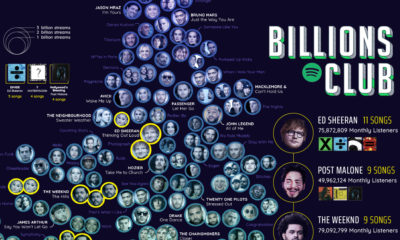Here’s how the top 15 news sites compare when ranked by monthly visitors, as well as the number of states the news source is most searched for in: Political affiliation plays a large role in determining each state’s favored news sites. Blue states lean towards Google News and CNN, while red states overwhelmingly choose Fox News.
The Most Popular News Sites
Yahoo News is the most popular news website in America, bringing in a massive 175 million monthly visitors. In addition, they’re the most searched for news site in 12 states—the highest of any website. The company’s history has been a roller coaster ride and at different times Yahoo intended to acquire Google and Facebook. Both companies went on to be worth over $1 trillion each, while Yahoo shrank some 90% from when it was once worth $125 billion. The New York Times has 60 million monthly visitors, but in recent years, has pivoted towards the coveted and trending paid subscription model. This decision is paying off well, as the site now has 6.1 million paid subscribers—more than any of its competitors. Consequently, the New York Times’ share price hit a record high in December 2020. HuffPost, and their audience of 110 million, were bought by BuzzFeed from Verizon in November of 2020. The two organizations have some history together, as BuzzFeed co-founder Jonah Peretti was also one of the early founders of HuffPost. CNN is seeing a fall in ratings ever since Donald Trump left office. By some measures has witnessed a 36% decline in primetime viewers in the new year. Google News experiences 125 million visitors a month, ranking second overall. That said, they stand tall relative to their competitors by overall visits to their main site. Here, Google hits 92.5 billion monthly visits, while Yahoo experiences a more modest 3.8 billion. Unlike legacy media news companies, Google has managed to increase their market share of U.S. advertising revenues, due to more ads going digital.
The Modern News Landscape
Overall, the modern news industry has been a tough landscape to operate in. Here are some of the reasons why: First, the internet has removed barriers to where people obtain information, and revenue streams have been disrupted in the process. The advertising business model of news organizations is cutthroat to compete in, and there has been plenty of consolidation and layoffs. Lastly, trust in traditional news and media organizations has been declining amongst Americans, from nearly 60% to 46% since 2019. To add to this, on a global basis, the U.S. ranks well below most major countries based on trust in news media. Some organizations like The Washington Post and The New York Times have opted out of the advertising model, moving towards the direction of premium subscriptions. But only 20% of the Americans pay for their news, which could lead to stiff competition down the road.
The Future Of News
There are serious concerns about the future of news in the era of spreading misinformation. Up to 43% of Americans say the media are doing a very “poor/poor job” in supporting democracy. But despite this waning trust, 84% of Americans view news media as “critical” or “very important”. What will the future of media look like throughout the 21st century and how will this impact the most popular news sites of today? on Even while political regimes across these countries have changed over time, they’ve largely followed a few different types of governance. Today, every country can ultimately be classified into just nine broad forms of government systems. This map by Truman Du uses information from Wikipedia to map the government systems that rule the world today.
Countries By Type of Government
It’s important to note that this map charts government systems according to each country’s legal framework. Many countries have constitutions stating their de jure or legally recognized system of government, but their de facto or realized form of governance may be quite different. Here is a list of the stated government system of UN member states and observers as of January 2023: Let’s take a closer look at some of these systems.
Monarchies
Brought back into the spotlight after the death of Queen Elizabeth II of England in September 2022, this form of government has a single ruler. They carry titles from king and queen to sultan or emperor, and their government systems can be further divided into three modern types: constitutional, semi-constitutional, and absolute. A constitutional monarchy sees the monarch act as head of state within the parameters of a constitution, giving them little to no real power. For example, King Charles III is the head of 15 Commonwealth nations including Canada and Australia. However, each has their own head of government. On the other hand, a semi-constitutional monarchy lets the monarch or ruling royal family retain substantial political powers, as is the case in Jordan and Morocco. However, their monarchs still rule the country according to a democratic constitution and in concert with other institutions. Finally, an absolute monarchy is most like the monarchies of old, where the ruler has full power over governance, with modern examples including Saudi Arabia and Vatican City.
Republics
Unlike monarchies, the people hold the power in a republic government system, directly electing representatives to form government. Again, there are multiple types of modern republic governments: presidential, semi-presidential, and parliamentary. The presidential republic could be considered a direct progression from monarchies. This system has a strong and independent chief executive with extensive powers when it comes to domestic affairs and foreign policy. An example of this is the United States, where the President is both the head of state and the head of government. In a semi-presidential republic, the president is the head of state and has some executive powers that are independent of the legislature. However, the prime minister (or chancellor or equivalent title) is the head of government, responsible to the legislature along with the cabinet. Russia is a classic example of this type of government. The last type of republic system is parliamentary. In this system, the president is a figurehead, while the head of government holds real power and is validated by and accountable to the parliament. This type of system can be seen in Germany, Italy, and India and is akin to constitutional monarchies. It’s also important to point out that some parliamentary republic systems operate slightly differently. For example in South Africa, the president is both the head of state and government, but is elected directly by the legislature. This leaves them (and their ministries) potentially subject to parliamentary confidence.
One-Party State
Many of the systems above involve multiple political parties vying to rule and govern their respective countries. In a one-party state, also called a single-party state or single-party system, only one political party has the right to form government. All other political parties are either outlawed or only allowed limited participation in elections. In this system, a country’s head of state and head of government can be executive or ceremonial but political power is constitutionally linked to a single political movement. China is the most well-known example of this government system, with the General Secretary of the Communist Party of China ruling as the de facto leader since 1989.
Provisional
The final form of government is a provisional government formed as an interim or transitional government. In this system, an emergency governmental body is created to manage political transitions after the collapse of a government, or when a new state is formed. Often these evolve into fully constitutionalized systems, but sometimes they hold power for longer than expected. Some examples of countries that are considered provisional include Libya, Burkina Faso, and Chad.













